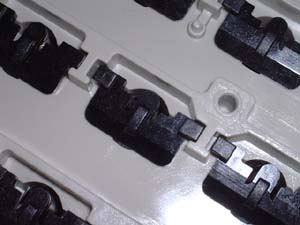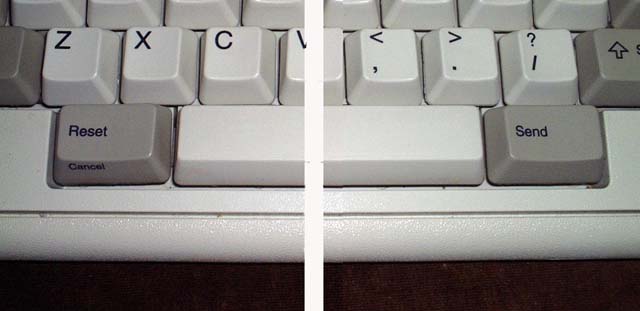|
42H0468
Variation of M2
Buckling Spring
Technology
Membrane switches
RJ-11 Plug ( modular jack )
|
Got an M2 variant P/N 42H0468, a terminal
keyboard with an RJ11 type plug.
I'm not sure but it's told that the keyboard is essentially
for
IBM terminal 3153. But it can be used with usual PS/2s or AT compatible
computers (
or should I say Wintel system ? ) . All you need is
LOVE for IBM Keyboard and just
to make
an adapter like this ( top page ; Qwerters
Clinic ) .
Key Top Letters
Some keys of this board are bit different from usual M2 ( and PS/2
keyboards).
Three keys beside F12 are [Print], [Print Line], [Hold].
Upper end of Num keys are [ Num Lock] ( as usual ) then [Jump], [Send
Line] and [ - ].
[End] key position is marked as [ <- Tab ], Page
up/down are [Clear] and [Erase EOF].
[ALT] keys beside space bar are changed to [Reset] and
[Send]. See below.
Usual M2 key top printing ( for comparison )
| Following five pictures are M2 P/N 1395300
( anyway they are almost same ). |
 |
 |
 |
Coil spring is same with that used
in Model M, same length and same diameter.
..... But feels very different.
Silicone grease treatment is recomended. |
 |
In order to pull off bottom case,
you have to pull out all the keys first, then release two screws
at the bottom, next you have to release 12 or 13 latches
at the front side.
Turn over the bopard up side down and pull the bottom case
upward.
Every rockers with coil spring are merely pressed upward just
with the bottom case together with membrane sheets and a
rubber
sheet. |
 |
|
Model M2 variation
1395300
; Buckling Sprig Technology. US layout
1395706 ; same as above , UK layout
73G4614
; Rubber Dome Spring
60G0817
; Rubber Dome Spring, with a big face plate. code name "Lion "...silly
joke.
60G3507
; Buckling Spring Technology. Labeled as M1...
funny enough.
Brief information about M2 is available at 3m3718.com
. The editor of the web site says "there is an overall "cheapness" than can not help being felt when using this board.
.... snip ...... Remember, if it's not buckling spring technology, it's crap."
.
Actually it's a crap as an IBM/Lexmark product. Buckling
sound is noisy and not, err... sophisticated unlike model M. But if you
put just a small dose of silicone grease around each buckling
spring, the "cheap and crappy noise" will disappear and the board
will generate mild clicky sound.
About silicone grease; Model
M P/N 8184692 ( Japanese page ) is an example which you can
see silicone
grease added to every buckling springs. If you add grease
too much, you'll loose buckling sound completely like P/N 8184692.
Plastic made control arms
Be careful when you pull out larger keys with a control/guide arm (
usually described as a stabilizer ) from M2 series keyboards. Control arms are made of
plastic and those keys are one-piece made with a control arm and
they are easy to break. When you pull out a space bar, you have to
release two latches of the control arm first ( circled blue
in the picture below ) or the stabilizer bar will be broken
easily. In order to release latches, push a projection
on the arm which is locked in a hole of a stopper standing on a base
plate toward outer direction and then lift up the arm, do same for
the another projection at the opposite end.
 |
 |
|
|
 |
You can release the latches using a thin minus
driver.
I used a hand made tool to release the latches. Main purpose of
the tool is for pulling out a outer case of Cherry mechanical
switches mounted on a PCB directly. |
 |
 |
I recommend you NOT to disassemble M2
series keyboards. If you do, you may have some difficulties to
assemble the keyboard. I myself disassembled three M2
keyboards including this one but every time I did I thought I'd
never do it again.
......but Never say Never. I may do it again and again because I
am a
MAD.
Making an adapter for 42H0468
I used an extension phone connector and a PS/2 cable pulled
out from a non-functional mouse.
RJ-11 receptacle used in the kit has only 4 pins placed middle of six
rows and the pin assignment didn't fit to the RJ-11 modular jack from the
keyboard. Then I pulled off the RJ11 receptacle and disassemble
it, replaced the pins in order to meet the RJ-11 jack from
the keyboard.
Checked each signal assignment of a dead mouse
and soldered each cables to pins of RJ-11 receptacle. It works just
fine though some of key tops marked different from usual PS/2
keyboard.
|
PIN OUT of RJ11 & PS/2 PLUG |
 |
 |
 |
Cool. Isn't it ? |
|




















